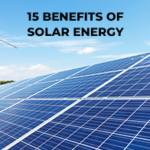Cons of renewable energy in the US – A Comprehensive 2023 Guide
Renewable energy has quickly grown in popularity as an approach to meeting world electricity demand and combating climate change, yet its drawbacks must be noticed. “US Energy Discounts” explore these disadvantages of renewable energy in this comprehensive 2023 guide aimed at US residents.
Cons of Renewable Energy
1) High Initial Cost
One of the most significant limitations of renewable energy sources such as solar, wind, and geothermal can be their high initial costs. At the same time, long-term cost savings from switching may outweigh these initial expenses. Unfortunately, this creates barriers to adopting them into homes or small businesses’ budgets, making the transition difficult or impossible altogether.
It requires specific infrastructure like solar panels, wind turbines, and storage batteries that may increase initial costs significantly – this high price point may explain why many still depend on traditional forms of energy such as coal.
2) Intermittency Issues
Renewable energy has one major drawback – intermittency. While traditional forms such as coal or natural gas depend on consistent weather patterns to produce electricity, their output from sources like wind or solar can vary substantially due to weather-dependent generation methods like windmills. That makes their output unpredictable.
Solar and wind energy sources only become accessible during daylight hours when there’s enough sun for photovoltaic cells. Their intermittency makes it challenging for grids to ensure reliable electricity supplies during peak times.
3) Devices Need Recycling
Producing electricity from these sources results in less pollution. However, these sources are susceptible to some issues because they are made, and their disposal processing could release pollutants.
For instance, solar cells will likely function appropriately over time, so we should eliminate them. However, these gadgets could be harmful, and because of this, we should come up with a recycling method to use the devices.
4) Availability Issue
Natural forces are the source of renewable power, highly dependent on weather conditions. So, if you experience adverse weather conditions, sources like solar cell technology will have less usage.
In the case of rain, PV panels won’t produce electricity. Consequently, you need to return to traditional sources.
5) Land issues
They often require large tracts of land to operate effectively; solar requires extensive lots for solar panels, while wind turbines need vast open spaces to function optimally – creating land use issues in densely populated regions with increased competition for space.
Their infrastructure installation may seriously impact wildlife habitats and ecosystems in sensitive areas, leading to conflicts between energy development and biodiversity conservation.
6) Energy Storage Difficulties
Sources, like wind and solar, depend heavily on weather conditions for their output of electricity; electricity storage systems need to store any surplus generated during periods of high production and release it when required – however, these systems tend to be expensive and require dedicated infrastructure; both can present barriers for renewable adoption.
Furthermore, electricity storage systems such as lithium-ion batteries may pose environmental concerns during their manufacture and disposal processes, creating tensions between renewable power’s environmental benefits and those imposed by electricity storage solutions such as lithium batteries.
7) It Can be Unreliable
Their energy technologies depend upon the day’s conditions (e.g., sun, wind) to harness energy. If the weather conditions aren’t ideal, renewable energy technologies will not be able to produce any electricity.
- Hydro generators need enough rain to replenish dams with their supply of water flowing.
- Wind turbines require wind to blow at a minimum speed to rotate their blades.
- Solar panels require sunlight and clear skies for the necessary heat for electricity generation; at night, it’s not collected.
8) Transmission and Distribution Inefficiencies
These sources often reside in remote regions, leading to inefficiencies in transmission and distribution. Energy generated from these sources must often travel long distances before reaching its end user resulting in energy losses and lower efficiency levels.
Further, grids may need to be more capable of accommodating the fluctuating supply and demand patterns associated with sources like wind or solar. It leads to instability and makes stable supply challenging to achieve. That makes maintaining reliable electricity supplies much harder.
9) Not Always a Commercially-viable Option
To be successful, renewable energy has to have the support of a distribution network that will move the energy to where it is needed. The networks must use non-renewable energy to be created to offset the benefits of renewable power.
It’s also subject to manipulation by political pressure. If these sources are considered a priority for the political system, the sector tends to stay caught up, and a preference for non-renewable options diminishes innovation.
Conclusion
It offers numerous advantages, from cutting carbon emissions and increasing energy security to its multiple drawbacks, such as its high initial costs, intermittency issues, land use concerns, storage challenges, and inefficiency during transmission and distribution in the US.
However, while they do have benefits, they also come with significant drawbacks that cannot be overlooked, including high initial costs, intermittency concerns, land use restrictions, and inefficiencies related to transmission and distribution – among many others.





